Dr. Dennis Hancock, UGA forage extension specialist and coordinator of the program, promised attendees that they would dig deeper, “both figuratively and literally” (Figure 1). The program culminated in participants examining the root systems of summer annual forage mixtures in a soil pit dug through forage plots at UGA’s Iron Horse Plant Sciences Farm.
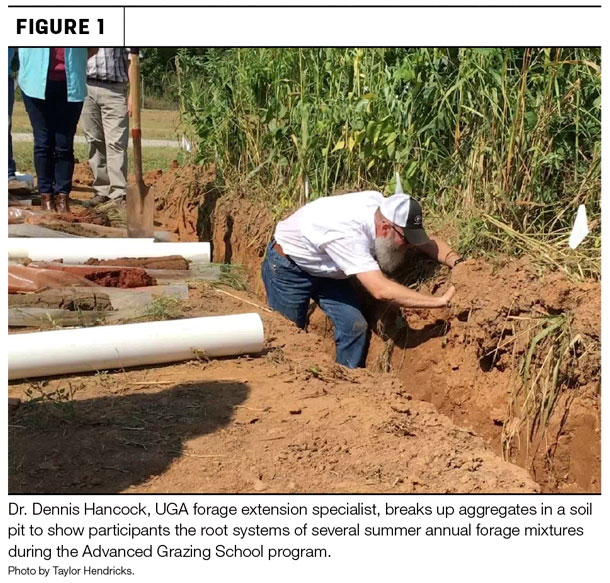
“This program is more advanced than our typical grazing programs because we are showing folks how the forage produced above ground feeds the roots and soil below the ground,” Hancock said. “The soil is alive. Understanding how it feeds and breathes is crucial to forage management.”
Discussion centered around improving soil health through a variety of methods, including soil organic matter and nutrient cycling. Organic matter influences several other soil properties, including cation exchange capacity, water holding capacity, aggregation and nutrient availability. In the case of water holding capacity, a 1 percent increase in soil organic matter in the top 6 inches can increase the amount of plant-available water by 3,500 to 6,000 gallons per acre.
Dr. Dory Franklin, an associate professor focusing on sustainable agriculture, and Laura Ney, a Ph.D. student in Franklin’s lab, highlighted the importance of “bio-management” to promote soil health and agricultural sustainability. Bio-management is employing strategies that seek to create an intricate and balanced web at every level – from the bacteria to the cattle – to achieve sustainability and production goals on the farm. She reminded producers that “a healthy, breathing soil is the foundation to resilience leading us to sustainability … providing a reserve for dry times and a filter to purify our water.”
Another major focal point of discussion included hands-on soil demonstrations, coordinated by Tayler Denman, a master’s student in the department of crop and soil sciences. Demonstrations highlighted a range of soil properties from soil pH and aluminum toxicity to soil infiltration rate. In the soil pH and aluminum toxicity demonstrations, participants were shown how seedling root development is sensitive to low pH.
The effects of soil pH were shown on a larger scale with bermudagrass grown in root tubes (Figure 2). In a highly acidic soil, plant growth can be stunted due to limited nutrient availability, leading to shorter roots with fewer root hairs for nutrient uptake.
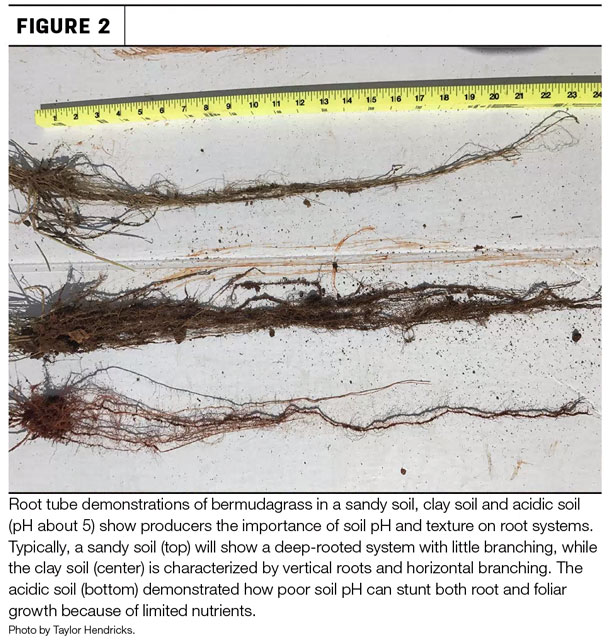
Demonstrations also showed how management of soils affects different soil properties, including aggregate stability and porosity. These demonstrations were used to show how plant roots and the fungi that grow on them help to “glue” the soil into aggregates. These aggregates are stable and full of pores that hold water and air. Well-managed pastures and no-till cropland have strong soil aggregates untouched by tillage. These aggregates are soil particles glued together by glomalin, a group of protein-sugar compounds secreted by fungi. When soil is frequently disturbed, glomalin production is reduced and aggregates break down into fine particles. In the demonstrations, producers placed soils under different management practices in beakers of water. Soils with good aggregate stability stayed together, while those under disruptive management quickly broke down into its smaller aggregates (Figure 3).
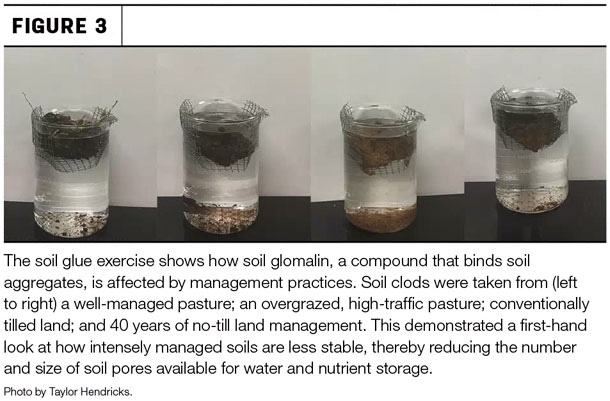
Differences in soil porosity were also shown in the demonstrations. For plants and the microbial population within the soil to operate effectively, there needs to be plenty of oxygen within the pores of the soil. Over time, management practices such as frequent tillage can decrease the pore spaces within a soil. Good grazing management helps increase both porosity and aggregate stability.
Improving biodiversity to create redundancy within the system was also a key theme. This redundancy, according to Franklin, is a critical factor for the system to be resilient since it ensures that there are multiple organisms fulfilling the necessary functions. This redundancy prevents the system from breaking down in the event of extreme weather or environmental stress. Earthworm farm demonstrations and observing dung beetle activities on a pasture walk helped participants visualize the role of macrofauna within the soil web (Figure 4). Denman explained the value of these demonstrations, saying “People sometimes forget how important earthworms and other organisms are to soil health. Being able to see the actual mixing of the soil done by the earthworms really helped people understand just how much work earthworms do.”
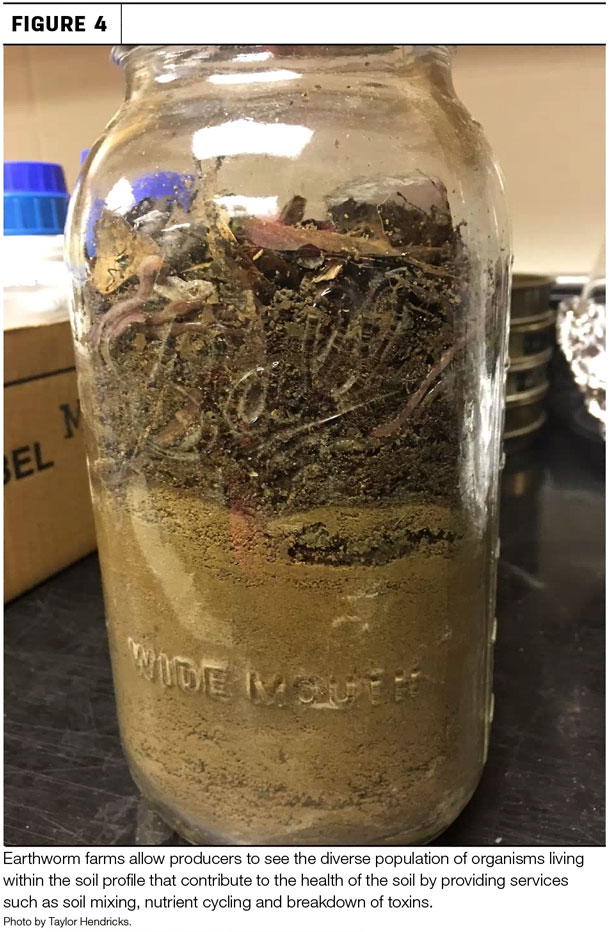
Bio-management, however, does not just include the microbes. It also affects the way the forages and cattle are managed. Additional forage root tubes showed participants how their grazing management program might affect the forage resiliency in their pastures. Pearl millet and bermudagrass were grown in root tubes and then cut at intervals (two, seven and 21 days) to simulate the improvements when forage crops are given more rest between grazing. When the tubes were opened, participants could see how the overgrazed plants were prevented from building deeper and larger roots. The short, stunted roots on the overgrazed plants contrasted with the roots of plants given proper rest. More rest resulted in a deeper, more extensive root system with fine lateral roots and mycelia growth extending through the soil profile (Figure 5).
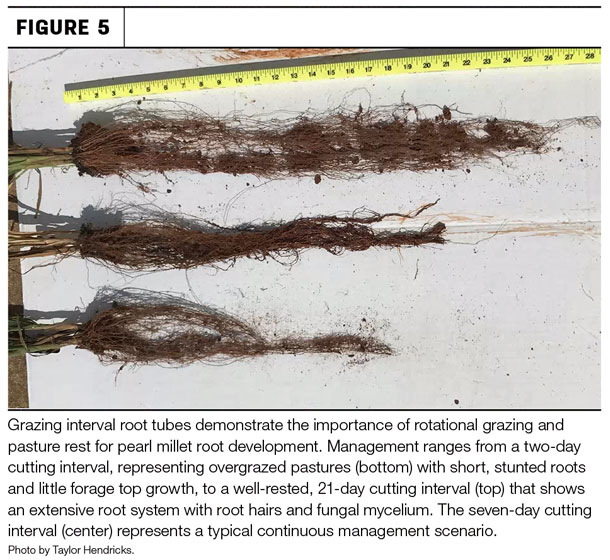
This soil health-focused advanced grazing school offered producers the opportunity to have an in-depth look at the whole system, not just the forages and the cattle. The goal was to encourage them to look beneath their feet and dig deep. The participants were left with a greater appreciation for how good grazing results in deeper roots and builds better soils, and they were challenged to use the principles to positively and sustainably influence soil health on their farms. ![]()
Taylor Hendricks is a Ph.D. student in the animal and dairy sciences department at the University of Georgia. Email Taylor Hendricks.








